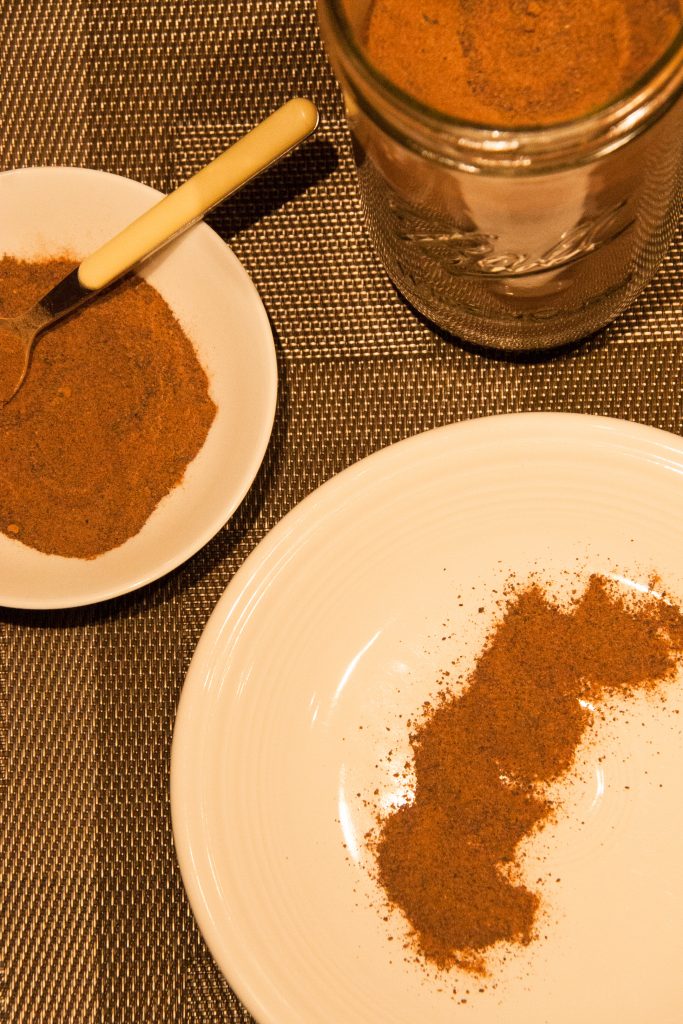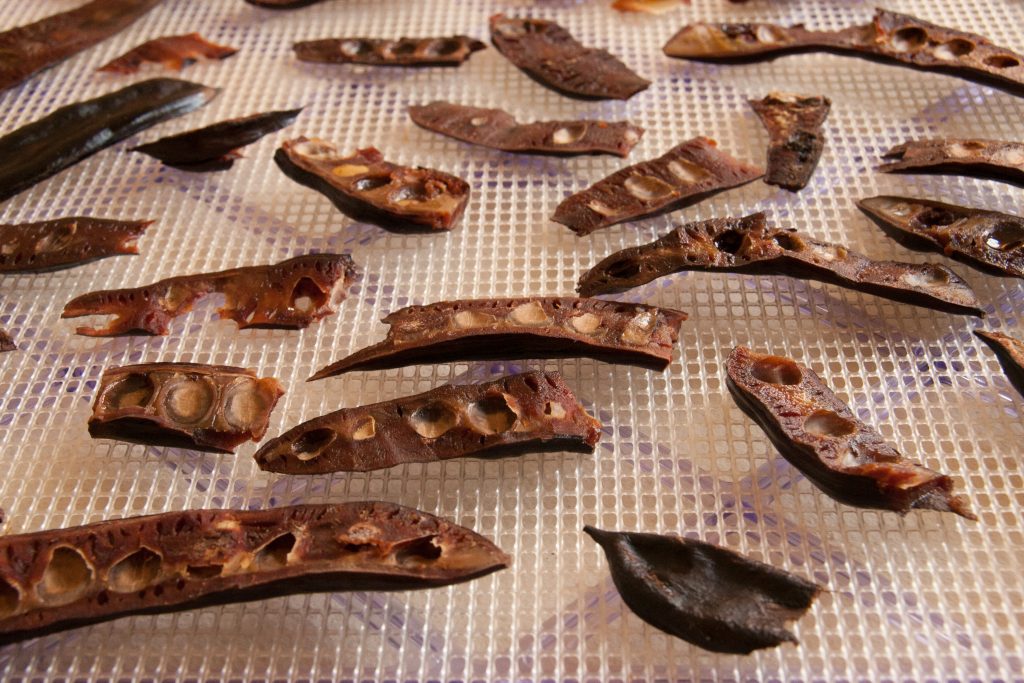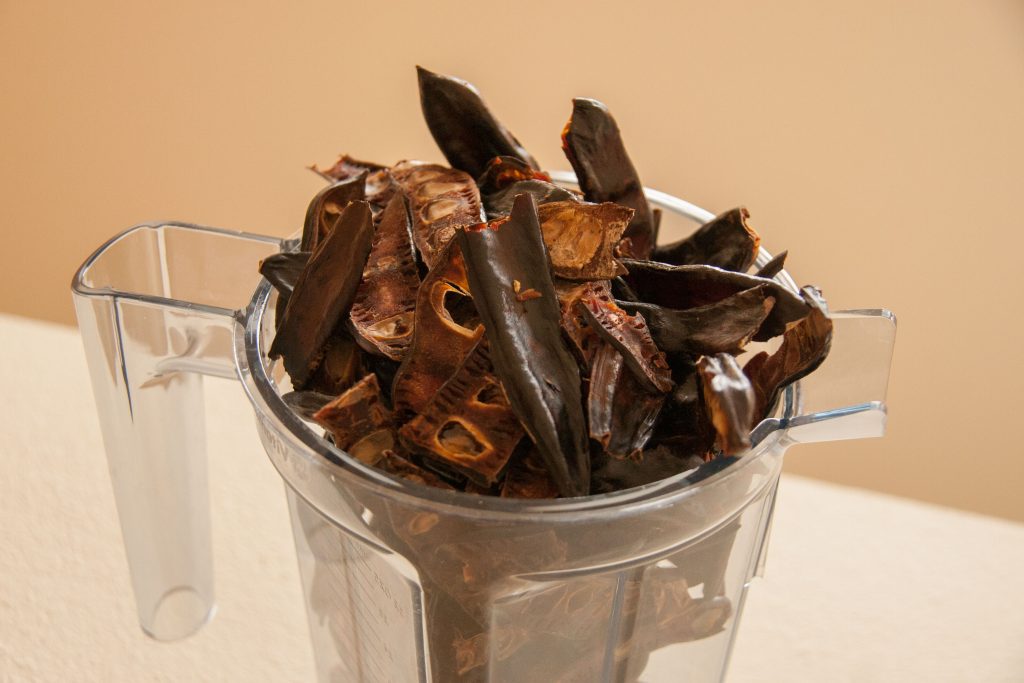
It doesn’t take long to get addicted to the flavor of carob. Taste it once and you’re hooked. And if you’re lucky enough to live where carob trees grow, making your own powder is easy to do at home. It takes a little time, but it’s not difficult, and the flavor and smell of fresh carob make it all worthwhile.
1. Clean your Carob Pods

After you’ve harvested your carob pods, bring them back to the kitchen and rinse them off. Since carob pods can be gathered from the ground, they’re often a little dusty and benefit from a good wash.
2. Boil and Soak to Soften the Carob Pods

Next, place them in a large pot and completely cover them with water. Bring the pot to a boil and simmer for 10 – 15 minutes, then turn off the heat and let the pods soak for 5 – 6 hours or overnight.
3. Split the Carob Pods and Remove the Seeds

It’s the flesh of the carob pods that’s tasty and sweet. Slice each softened pod horizontally down the middle, revealing the very hard seeds inside. Remove the seeds and throw them away. Or plant them, if you live someplace where the climate is right for growing carob trees! In the U.S., carob is hardy to USDA hardiness zone 9, or zone 8 with winter protection.
4. Dry the Carob Pods

If you have a dehydrator, dry the split pods at 125F for as long as it takes to make them easy to snap in two. To speed this up, you can tear the pods into one inch pieces or give them a rough chop in a food processor. If you don’t have a dehydrator, place the pieces in a single layer on a cookie sheet in the oven at the lowest possible setting.
5. Grind the Dried Carob Pods
Once the pieces are dry enough to snap, pour them into your blender. The dry grains canister of my Vitamix did an excellent job, but regular blenders will also work and you can do small batches in a spice or coffee bean grinder.
6. Refine the Carob Powder

You’ll end up with two sizes of carob particles: a very fine powder and a slightly larger granule. The larger granules won’t dissolve in solution, so if you want a perfectly smooth pudding or hot beverage, separate the powder from the larger granules, using a fine sifter or a jelly bag. The coarser granules can be used in baked goods and raw carob candies.
Now that I’ve learned to appreciate carob, I can’t stop thinking of ways to use it: carob horchata, carob pudding, carob coconut balls, black walnut carob bars… I’m going to need some more pods.

Thank you for your recipe Ellen. I am creating a movement and the more I look for authentic material the more I meet wonderful people like yourself, Robin Wall Kimmerer and Deb Soule! I look forward to connecting. Bern Jacqueline
https://gardenoflife.global
Thanks very much!
Thanks for that recipe. I’ve got a batch of broken carob that’s been soaking in alcohol to make carob liqueur. They smell too good to chuck away so I’m drying them out to powder them in a coffee grinder. See what happens
Dude! How did I never think of that?! I’ve got several great cocktails made with carob syrup, but a direct infusion is a great idea. Thanks for sharing.
Hi Ellen, I have two mature carob trees in my yard. I would like to find someone in Las Vegas who would be interested in harveting the pods. I am unable to reach them on the tree. Would you have any recommendations?
Hi Bobbi, lucky you! Are you Las Vegas, NV? If so, I don’t know anyone in that area, so I don’t know who might be interested in the pods. I’m not far from Las Vegas, NM, but I’m pretty sure it’s too cold there for carob. If you can’t get a ladder to reach the pods, you can wait until they fall. I’ve harvested from the ground before and they may be a little dusty, but they’re usually fine. Best wishes!
I don’t have a carob tree. I harvest all mine from the sidewalks, tops of hedges, and edges of yards after they’ve fallen. After washing and boiling, no worries about germs and debris.
So far I only use mine for DIY gluten-free coffee substitute so I don’t even grind them very small. I stop when the largest pieces are the size of red lentils.
Hi Emily, I’m curious about your using carob as a “gluten-free coffee substitute”. I know coffee itself is gluten-free. Are there coffee substitutes with gluten in them? I’ve never heard of that! Please let me know.
I don’t have a carob tree. I harvest all mine from the sidewalks, tops of hedges, and edges of yards after they’ve fallen. After washing and boiling, no worries about germs and debris.
So far I only use mine for DIY gluten-free coffee substitute so I don’t even grind them very small. I stop when the largest pieces are the size of red lentils.
Hi Emily, I’m curious about your using carob as a “gluten-free coffee substitute”. I know coffee itself is gluten-free. Are there coffee substitutes with gluten in them? I’ve never heard of that! Please let me know.
The seeds are commercially used as a powder to thicken ice-cream, have you ever tried to boil them and see if it forms a gel?
I never have, have you? I usually only use the pods and get rid of the seeds.
Is the seed stimulated to sprouting after 10-15 minutes simmering/boiling in pod, or does it destroy their ability to sprout?
Hi John, I’m sorry but I have no idea! Carob won’t grow where I forage, so I’ve never tried to sprout the seeds. If you do, please let me know how it works.
Thank you so much for taking the time to write this post, very helpful and detailed and easy to follow, no ads, no or anything distracting perfect 🙂
You’re very welcome! I hate how some websites are loaded with distracting ads and have decided not to do that, even though I could make some $$ from them. I appreciate your appreciation.
I have a carob tree and it’s full of Carobs here in Sicily. God knows what to do with it all it would take months to grind it all by hand or blender. I must have around 100 kilos of the pods. What to do with it all?
Well that’s the thing about wild foods…many of them take a lot of work to process! Most of my carob recipes call for powder, but if you’d like to make something with the whole pods, I have a recipe for carob syrup here: http://backyardforager.com/how-to-make-carob-syrup-from-whole-pods/
In Portugal we take it to the local distributor and they pay us by the weight for it, last year it was very lucrative, apparently its gone down a bit this year
quite helpful